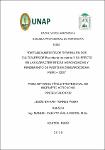| dc.contributor.advisor | Ávila Fucos, Manuel Calixto | |
| dc.contributor.author | Torres Paima, Jesús Briham | |
| dc.date.accessioned | 2022-03-07T17:04:08Z | |
| dc.date.available | 2022-03-07T17:04:08Z | |
| dc.date.issued | 2020 | |
| dc.identifier.uri | https://hdl.handle.net/20.500.12737/7850 | |
| dc.description.abstract | The research was carried out at the National University of the Peruvian Amazon in the Faculty of Agronomy in the Beef Project in the Fundo de
Zungarococha, titled planting distances in two cultivars of Brachiaria brizantha and its effect on the agronomic characteristics and pasture yield in
Zungarococha , Peru - 2019. The evaluations were carried out at the tenth week after sowing with vegetative seed (bushes), in plots of 3 mx 1.2 m (3.6
m2) and an experimental area of 141.1 m2. With a Complete Random Block Design (DBCA), with a factorial of 2 x 2 with four treatments and four
repetitions, the treatments under study were: T1 (Marandu culture x 0.5 mx 0.5 m), T2 (Xaraes culture x 0.5 mx 0.5 m), T3 (Marandu culture x 0.5 mx 0.5 m)
and T4 (Xaraes culture x 1.0 mx 0.5 m), obtaining the following results:. That the T1 treatment that has a distance D1 (0.5 mx 0.5 m) and with cultivar C1
(cv. Marandú), was able to increase the yield of green matter, dry matter, percentage of cover and the yields of green matter per plot and per hectare
(Kg), under the agroclimatic conditions of the research work. Therefore, it is concluded that, with less planting distances, the production of the evaluated
variables increases. In the same way, the Marandú cultivar was the one that showed the best results in the agronomic and yield characteristics of this
forage species Brachiaria brizantha. Similarly, the percentage (%) of coverage was also favored with the distance D1 (0.5 m x 0.5 m) and with the cultivar C1
(cv. Marandú). According to the results found in this work, Brachiaria brizantha (cv. Marandú), is presented as an alternative for the supplementation of the
dietary diet of monogastric and ruminant animals. In addition, it should be considered that with a sowing at distances of 0.5 m x 0.5 m. Favorable results
are achieved, it is a forage species that is easy to adapt to agricultural systems due to its easy propagation and handling in cultivation. | en_US |
| dc.description.abstract | La investigación se realizó en la Universidad Nacional de la Amazonia Peruana en la Facultad de Agronomía en el Proyecto Vacunos en el Fundo de
Zungarococha, titulado distanciamientos de siembra en dos cultivares de Brachiaria brizantha y su efecto en las características agronómicas y
rendimiento de pasto en Zungarococha, Perú – 2019. Las evaluaciones fueron realizadas a la décima semana después de la siembra con semilla
vegetativa (matas), en parcelas de 3 m x 1.2 m (3.6 m2) y un área experimental de 141.1 m2. Con un Diseño de Bloques Completo al Azar (D.B.C.A), con una
factorial de 2 x 2 con cuatro tratamientos y cuatro repeticiones, los tratamientos en estudio fueron: T1 (cultivo Marandu x 0.5 m x 0.5 m), T2
(cultivo Xaraes x 0.5 m x 0.5 m), T3 (cultivo Marandu x 0.5 m x 0.5 m) y T4 (cultivo Xaraes x 1.0 m x 0.5 m), obteniendo los siguientes resultados: . Que
el tratamiento T1 que tiene un distanciamiento D1 (0.5 m x 0.5 m) y con el cultivar C1 (cv. Marandú), se logró incrementar el rendiiento de materia verde,
materia seca, porcentaje de cobertura y los rendimientos de materia verde por parcela y por hectárea (Kg), bajo las condiciones agroclimáticas del trabajo de
investigación. Por lo que se concluye que, con menores distanciamientos de siembra, se incrementa la producción de las variables evaluadas. De la misma
manera el cultivar Marandú fue el que mostró mejores resultados en las características agronómicas y de rendimiento de esta especie forrajera
Brachiaria brizantha. De igual manera el porcentaje (%) de cobertura también se vio favorecido con el distanciamiento D1 (0.5 m x 0.5 m) y con el
cultivar C1 (cv. Marandú). De acuerdo a los resultados encontrados en este trabajo, Brachiaria brizantha (cv. Marandú), se presenta como una
alternativa para la suplementación de la dieta alimenticia de animales monogástricos y rumiantes. Además, se debe considera que con una siembra
a distanciamientos de 0.5 m x 0.5 m. se logra resultados favorables, es una especie forrajera de fácil adaptación a los sistemas agropecuarios por su fácil
propagación y manejo en el cultivo. | es_PE |
| dc.format | application/pdf | es_PE |
| dc.language.iso | spa | es_PE |
| dc.publisher | Universidad Nacional de la Amazonía Peruana | es_PE |
| dc.rights | info:eu-repo/semantics/openAccess | * |
| dc.rights.uri | https://creativecommons.org/licenses/by/4.0/ | * |
| dc.subject | Siembra | es_PE |
| dc.subject | Espaciamiento | es_PE |
| dc.subject | Pasto marandú | es_PE |
| dc.subject | Brachiaria brizantha | es_PE |
| dc.subject | Características agronómicas | es_PE |
| dc.subject | Rendimiento de cultivos | es_PE |
| dc.title | Distanciamiento de siembra en dos cultivares de Brachiaria brizantha y su efecto en las características agronómicas y rendimiento de pasto en Zungarococha, Perú - 2019 | es_PE |
| dc.type | info:eu-repo/semantics/bachelorThesis | es_PE |
| thesis.degree.discipline | Agronomía | es_PE |
| thesis.degree.grantor | Universidad Nacional de la Amazonía Peruana. Facultad de Agronomía | es_PE |
| thesis.degree.name | Ingeniero(a) Agrónomo | es_PE |
| dc.subject.ocde | http://purl.org/pe-repo/ocde/ford#4.01.06 | es_PE |
| renati.author.dni | 72871763 | |
| renati.advisor.orcid | https://orcid.org/0000-0002-5390-966X | |
| renati.advisor.dni | 05327621 | |
| renati.type | http://purl.org/pe-repo/renati/type#tesis | es_PE |
| renati.discipline | 811036 | es_PE |
| renati.level | http://purl.org/pe-repo/renati/level#tituloProfesional | es_PE |
| renati.juror | Urrelo Correa, Juan Imerio | |
| renati.juror | Pinedo Jimenez, Julio | |
| renati.juror | Aspajo Varela, Fidel | |
| dc.publisher.country | PE | es_PE |


